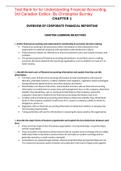Exam (elaborations)
Test Bank for Understanding Financial Accounting 3rd Edition By Canadian Edition, By Christopher Burnley
- Course
- Institution
Test Bank for Understanding Financial Accounting 3rd Edition By Canadian Edition, By Christopher Burnley Test Bank for Understanding Financial Accounting 3e By Canadian Edition, By Christopher Burnley
[Show more]



